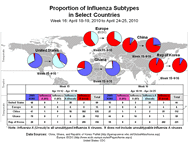2009 H1N1 Flu: International Situation Update
May 7, 2010, 6:00 PM ET
This report provides an update to the international flu situation using data collected through May 2, 2010, and reported by the World Health Organization (WHO) on May 7. WHO continues to report laboratory-confirmed 2009 H1N1 flu deaths on its Web page. These fatal cases are an under representation of the actual numbers as many deaths are never tested or recognized as influenza related.
Currently, the most active areas of 2009 H1N1 transmission are in parts of West Africa, the Caribbean, and Southeast Asia. 2009 H1N1 transmission appears to be declining in Ghana after peaking in April. Seasonal B viruses have become more prominent in Cameroon and the Democratic Republic of Congo. In Guatemala, an increasing trend in respiratory disease has been reported in recent weeks. Cuba has noted increased detection of severe 2009 H1N1 cases since March, but overall activity may have peaked the first week of May. Reports of school outbreaks due to 2009 H1N1 continue to occur in Malaysia.
Respiratory disease activity has increased in Bangladesh since mid-April and appears to be due to both 2009 H1N1 and seasonal B viruses. Respiratory disease activity remains low in East Asia, with influenza activity in some countries primarily attributable to seasonal B viruses. Influenza activity in the southern hemisphere is sporadic, though the ILI levels in one region in Chile have been slightly above the epidemic threshold for four weeks. Influenza virus circulation remains low in Europe.
Selected Highlights
- According to WHO, the majority of 2009 H1N1 virus isolates tested worldwide remain sensitive to oseltamivir, an antiviral medicine used to treat flu. Among 2009 H1N1 isolates tested worldwide, 285 have been found to be resistant to oseltamivir – 65 of these isolates were detected in the United States. Approximately 1.1% of U.S. 2009 H1N1 viruses tested by CDC since September 1, 2009, have been resistant to oseltamivir.
- Influenza B is the predominating influenza virus in certain countries, accounting for 83.3% of all influenza detections in the Russian Federation, 72.3% in China, 91.4% in the Republic of Korea, and 100% in Iran and Sweden.
- Some seasonal A (H1N1) viruses were detected in the Russian Federation, and Cuba, Ghana, and the Russian Federation reported some A (H3N2) activity.
- On February 18, 2010, WHO published recommendations for the following viruses to be used for influenza vaccines in the 2010-2011 influenza season of the Northern Hemisphere:
- an A/California/7/2009 (H1N1)-like virus;
- an A/Perth/16/2009 (H3N2)-like virus*;
- a B/Brisbane/60/2008-like virus.
* A/Wisconsin/15/2009 is an A/Perth/16/2009 (H3N2)-like virus and is a 2010 Southern Hemisphere vaccine virus.
International Resources for 2009 H1N1 Information
Health Organizations
- World Health Organization (WHO)
- ECDC (European Centre for Disease Prevention and Control)
- H2P (Humanitarian Pandemic Preparedness)
- Public Health Agency of Canada
World Health Organization (WHO) Regional Offices
- AFRO (WHO Regional Office for Africa)
- AMRO (WHO Regional Office for the Americas) / PAHO (Pan American Health Organization)
- EMRO (WHO Regional Office for the Eastern Mediterranean)
- EURO (WHO Regional Office for Europe)
- SEARO (WHO Regional Office for South-East Asia)
- WPRO (WHO Regional Office for the Western Pacific)
Travel and 2009 H1N1 Flu
Human cases of 2009 H1N1 flu virus infection have been identified in the United States and several countries around the world. For information on 2009 H1N1 flu and travel, see the CDC H1N1 Flu and Travel website.
Reports and Publications
- White House Report on 2009 H1N1 in the Southern Hemisphere
Issued August 2009 – This White House report was prepared by the Department of Health and Human Services (HHS) in coordination with the Office of the Director for National Intelligence (ODNI) and the Department of State (Dos) and describes the characteristics and impact of 2009 H1N1 influenza A virus in the Southern Hemisphere. - ECDC Interim Risk Assessment Influenza A (H1N1) 2009 Pandemic
Issued July 30, 2009 - This document provides an interim risk assessment of novel H1N1 flu in Europe prepared by ECDC. - World Health Organization Weekly Epidemiological record – Issued July 24, 2009
This document by WHO provides updates on the international novel H1N1 flu situation. - MMWR – Update: Novel Influenza A (H1N1) Virus Infection – Mexico, March-May, 2009 – Issued June 5, 2009 / Vol. 58 / No. 21.
This Morbidity and Mortality Weekly Report describes the novel influenza A (H1N1) outbreak in Mexico from March-May, 2009. - MMWR – Update: Novel Influenza A (H1N1) Virus Infections – Worldwide, May 6, 2009 – Issued May 8, 2009 / Vol. 58 / No. 17.
This Morbidity and Mortality Weekly Report describes worldwide novel influenza A (H1N1) infections as of May 6, 2009.
Get email updates
To receive weekly email updates about this site, enter your email address:
Contact Us:
- Centers for Disease Control and Prevention
1600 Clifton Rd
Atlanta, GA 30333 - 800-CDC-INFO
(800-232-4636)
TTY: (888) 232-6348 - Contact CDC-INFO
